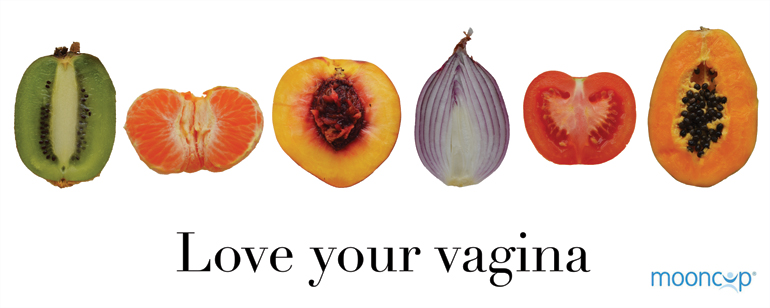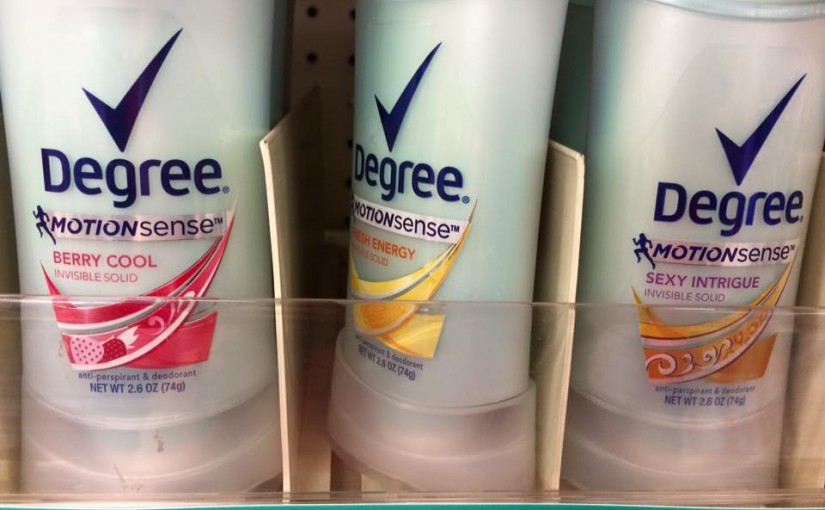A friend sent me the above picture and requested that I parse out why feminine armpits should smell like fruit or sexy intrigue. I asked for some further specifics regarding sexy intrigue. Imagine my disappointment that it did not smell, as I had hoped, like slim cigarettes and broken promises made in Paris, but instead like a cinnamon sugar cookie. The gauntlet has been thrown, and I shall retrieve it.
Now, one can take the expedient route and say this is just personal preference or “culture,” or one could probably write a book involving details about the history of personal grooming and perfume, cultural attitudes and expectations, the role of marketing, biological responses to scent, etc. I will attempt to pick and choose judiciously to come to an answer, but as this is not a peer-reviewed article or anything, keep in mind that this is more of my answer as opposed to “The Answer.” In order to do this properly, I’d also have to try to disprove my theories, hence the possibility of a book-length answer. I’m just going try to keep this simple.
Note: Whatever your preferences are regarding personal scents, grooming, etc., you do you. I’m not here to criticize anyone who wants to smell like delicious food, a bouquet of flowers, surprisingly earthy wine, or motor oil.
So, starting with the basics: pretty much as long as there has been civilization, humans have been altering their appearance and scent, that we continue to do so is no big surprise. Also, there are definite male and female scents, though it’s not bourbon vs. flowers the way scents are marketed to us. Studies show that, consciously or not, we pick up on messages in other people’s scent, including how well their genes may complement our own. In my own informal experience, I’ve accidentally bought cheese that smelled exactly like my dirty gym shorts. It was an undeniably female smell that was very far from “sexy intrigue,” except, perhaps, for those of more voluptuous natures like Napoleon, who famously requested that Josephine not bathe before his return. (The man also has some fan-wavingly good love letters.)
What does it mean then, that scents have been gendered beyond our natural, funky, information rich B.O.? I believe this is where some marketing comes in. Perfume, before the advent of cheap synthetics, was expensive and signifier of wealth, especially with additions of fragrant, exotic materials. (Think of what it would take for a 17th century European to obtain civet, cinnamon, jasmine, myrrh, sandalwood, etc.) This was also a time when you layered that perfume on top of your own stinkiness, perhaps making your own personal blend more personal. However, with the advent of cheap lab-made scent, everything and everyone seems to have a perfume. Also, by gendering scent, product makers are able to cheaply double their market groups. Instead of making one product with one smell, with low-cost colors and scents, you can make a plethora of “different” products that are designed to appeal to men and women separately. Marketing can also reinforce anxiety about defining masculinity and femininity through product usage, ensuring that these two marketing groups stay separate. There’s no doubt about who’s supposed to use this product:

It makes good marketing sense! Scent is a powerful sense for memory and emotion. The perfume in a product becomes a part of the experience of using that product. Remember these commercials?
This brings us to female armpits and what they’re “supposed” to smell like. First of all, at least in the U.S., the expectation is that a woman’s armpits are without hair. To a certain extent, women do have less body hair, and this is a way to further reinforce sexual differences. Removing armpit hair also reduces sweat being trapped in the hair, sweat which creates the original, “earthy” scent of a woman. Also, with a few exceptions like those with alopecia, armpit hair is a sign of adulthood for men and women. By removing armpit hair, women reduce the scent and sight of maturity. Some people simply find any and all armpit hair ugly, and prefer to remove it. This took off in the 1920s when removal of hair on newly exposed limbs was an excellent opportunity for the makers of safety razors. Before then, if a man got to see a lady’s armpits hair and all, he was likly in a very intimate, exciting situation. Nowadays, the armpit is usually nothing to get excited about: a smooth, scentless, and sexless expanse of skin on the arm. The shaved armpit is at once more and less sexy, but definitely considered more socially appropriate – probably because it shows that a woman is properly vigilant about her body.
In a way, scented deodorants, replace the earthy female B.O. with the societally approved feminine smell. Now, we are told, we can choose what our smell says about us, and we can make ourselves more attractive through appropriately gendered scent choice. Even though a female equestrian may smell of leather, horses, and fresh hay, while a male baker is more likely to smell of vanilla, spices, and fruit, these smells have become gendered. I certainly went through a smell of fruit/baked goods/heavy florals phase when I was an adolescent. Looking back, I was probably trying to experiment and get a grip on how to perform femininity properly.
Though why are women supposed to smell like baked goods and flowers? The beauty of lab-made scents is that you can create whole new unique scents, and more gender-neutral scents are just that; they’re described with words like fresh, cool, or clean. Here is the crux of the issue: unpacking why fruit, desserts, and flowers are associated with femininity.
The thing about fruit, pastries, and flowers is that they are decorative, colorful, considered trivial (unless you work in the industry!), and consumable. When you look back on historical descriptions of femininity, ideal women are often lauded for being decorative, adorably concerned with the trivial, and having a dangerous penchant for consumption that must be tempered through masculine influence. Pastries, fruit, and flowers are also items women are expected to consume and be trivially excited about, even today. Think of the tropes of a woman expecting flowers on her anniversary or squealing over the dessert cart at a restaurant. Fruit is generally sweet, colorful, and yielding to the touch – characteristics that are considered either feminine or desired by women.
Fruit is also feminine in that for hundreds, or even thousands of years, fruit has meant, well, lady bits. Note, also, that flamboyant men are called fruity, but there’s no similar insult for women.

My suspicion, then, is that both men and women are being marketed femininity as something that is consumable and, for women, requires significant upkeep. Femaleness, often laden with various bodily smells, needs to be replaced with socially accepted smells that are associated with feminine nature. It is much easier to smell female than it is to smell feminine. (How long does it take for me to stop smelling like a cupcake? Half a day? Less? Should I reapply?)
Women consume femininity directly as guided by social mores and marketing. (I buy pink clothes, I buy floral perfume, I make orgasm noises when I use Herbal Essences, etc., ergo I am female.) Men consume socially approved femininity through interaction with centerfolds, mainstream media, or even literally with women’s flavored personal care products. These are products that are supposed make women feel feminine and sexy in that they’re becoming more easily consumed by men (while underscoring anxiety so women keep buying), and make men feel masculine and attracted due to the manufactured gender differences in scent and what those scents mean (if heterosexual.)
So are fruity personal care products sexy and feminine? For some people they certainly are. If we’ve learned anything from anthropological studies about sex and attraction it’s that people learn what sexy is from their culture and environment. This is even true for rats: http://www.ncbi.nlm.nih.gov/pubmed/7122734. In our culture, someone smelling your B.O. is considered extremely embarrassing. However, it appears that scent is an important part of how we present ourselves, so we choose scents that fit how we wish to be viewed: feminine, alluring, sporty, etc. The way these scents are modeled are based off of our own cultural assumptions about what it means to be these things: feminine means flowers, sporty means that nebulous “cool, fresh” scent. The use of scents in lotions, deodorants, shampoos, and soaps are part of the product maker’s attempt to associate their products with these feelings. Sure, it’s part of the U.S.’s way of consuming our feelings, and that can feel kind of icky, but it shouldn’t stop someone from using products that make them like the way they smell. However, there is something to be said for examining our preferences and why we have them.
